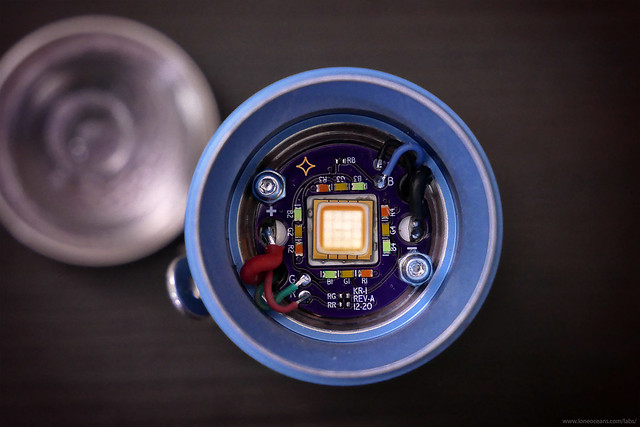I updated the first post with some additional photos and images, and more to come soon..

Above is a photo where you can admire the bare LED die construction.

Here's a comparison shot - what are they? Scroll to the first post to see :)
Thanks everyone for your interest and kind words.
For the converter, I purchased the TPS61288 from TI directly a few months since I built a development board for this project to fine tune the circuitry and to ensure everything works as well as possible before building a form-factor PCB. Though as pointed out, it's now out for sale on Digikey and other distributers soon. I also did a little component optimizing in terms of cost, and the BOM cost for this board is actually a good bit less than say the GXB172.
The general maximum input power is 40W if a good cell is used. One shouldn't simply look at the quoted maximum current input for the converter IC, since this maximum current depends on a lot of other factors as well such as inductor choice, switching frequency, load etc. I did some quick analysis and found it to be more a smidge more efficient across the range compared to the MP3231/29/32, and also because maybe I'm baised towards TI since I've used a lot of their PMICs and I do like their implementation. The idea of the Lume series of drivers is to create practical and reliable implementations, not to make lumen monsters, so I focused on efficiency & practicality instead of absolute maximum turbo modes.
For multiple cells in parallel, I always feel uncomfortable with consumer flashlights using inherently power dense cells in parallel or series without a BMS. It's generally OK in practice if the user uses three well matched, new, cells together, but problems quickly happen if the cells are not matched.
This driver is designed specifically for the use cases of today's high power, single, 18650, 26650 and 21700 cells. The maximum power handling capability is designed around this power source. If multiple cells are used in series or parallel, significantly more powerful drivers can be created; for example if a 4680 cell comes into consumer production, I could make something like a GXB100 for it. If multiple cells are used in series, then it makes sense to design a higher voltage buck regulator.
Agro, I'm using the Coilcraft XAL7030 inductor for this particular build, though a bigger inductor like the XAL7070, 8080, or 1060 would be better choices. This inductor choice is limited by the physical size of the driver cavity, and I reduced the maximum power output slightly for this particular build due to this reason. The 3mm value refers to the z-height of the inductor.
Speaking of which, just wanted to point out that the Lume X1 is not a particular driver, but a general design topology. I don't think this driver as-is is remotely suitable for most hobbyists to assemble at home unless you're comfortable with soldering QFN packages on a daily basis! It is also currently designed specifically for the KR1 host (25mm diameter), which is also non-ideal since the KR1 is a lousy host as-is, and I don't think most people would want to mill out their flashlight to fit a driver. Most likely, a new driver needs to be designed for a specific flashlight.
Perhaps if lots of people are interested, hopefully we can convince some manufacturer to pick it up for their light to create something special. Personally I'd like to see a compact, side E-switch, single emitter (or multiple in parallel) light made by Hank with the build quality and design he's known for (just a personal preference, no hard feelings to other manufacturers). They could offer two variants - one with the usual linear driver and 3V LEDs, and one with the Lume X1 driver and a 6/12V LED,.. but that's not for me to decide. :)

